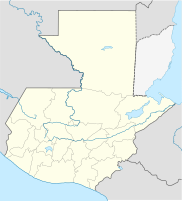Sololá
| Sololá | ||
|---|---|---|
|
Coordinates: 14 ° 46 ′ N , 91 ° 11 ′ W Sololá on the map of Guatemala
|
||
| Basic data | ||
| Country | Guatemala | |
| Department | Sololá | |
| City foundation | 1547 | |
| Residents | 20,000 | |
| City insignia | ||
| Detailed data | ||
| surface | 94 km 2 | |
| Population density | 213 inhabitants / km 2 | |
| Waters | Lake Atitlán | |
| Time zone | UTC −6 | |
| City patron | Virgen de la Asuncion | |
| Website | ||
| Sololá - Torre Centroamericana | ||
Sololá is a city in Guatemala and has almost 20,000 inhabitants. It is the administrative seat of the Department of Sololá and the large municipality of the same name ( Municipio ), which extends over an area of approx. 94 km² and has around 60,000 inhabitants. About 90 percent of them are cakchiquel and quiché . The city is the seat of the Catholic diocese Sololá-Chimaltenango .
Location and climate
The city is located about 140 km west of Guatemala City in the central highlands of the Sierra Madre at an altitude of 2,114 m. You can reach Sololá from Guatemala City on the Interamericana (CA 1) and the national road 1, which branches off to the south at El Cuchillo (Los Encuentros). This road leads via Sololá to Panajachel on Lake Atitlán (1,562 m). The climate in Sololá is temperate.
Economy and tourism
Sololá has long been a commercial center with a market that takes place on Tuesdays and Fridays. In contrast to Chichicastenango , it has largely retained its original character, although Sololá is exposed to steadily increasing tourist traffic due to the proximity of Lake Atitlán. In addition to trade and tourism, agriculture and the production of mud bricks ( adobes ) play an important role.
In a former barracks there is a branch of the agricultural faculty of the Universidad del Valle (Guatemala City).
history
The area of Sololá was first ruled by Tzutuhiles before the arrival of the Spaniards . Then Quichés and Cakchiquels joined them, who initially all lived together in the pre-Columbian village of Tzolohá (or Tzoloyá, Tzolojha , depending on the transcription ; Eng . "Elderberry Water "), but then separated. In 1547, near this settlement, of which only sparse remains have survived , the Spaniards founded Asunción de Nuestra Señora de Tecpán Atitlán , also known as Tzololá or Asunción Sololá . Until 1730 the place was the administrative seat of the Corregimiento de Tecpán Atitlán (Sololá) , then the Alcaldía Mayor de Sololá . Even after independence from Spain , the place became the administrative seat of districts of various shapes and sizes, in 1872 also the department of Sololá, which still exists today .
Attractions
- The main attraction of Sololá is the market ( mercado ), which spreads along the narrow streets of the town; food and everyday items are still mainly traded here. You rarely see tourists. Many women still wear the traditional clothing developed during the Spanish colonial period, consisting of a wrap skirt ( uq or corte ) and a colored embroidered or woven shirt ( po't or huipil ); the multi-layered headgear ( tzut ), on the other hand, has become rare. The men's clothing that has become typical in the 20th century consists of a shirt with an American check pattern, knee or ankle-length richly embroidered trousers and a sash wound around the hips ( faja ); only rarely do the men still wear their embroidered shirts.
- In the heart of the city is the geometrically designed Plaza Mayor with a central elevated pavilion for the musicians who play here on festive days.
- The town's church is a single-nave, several times restored building with a crossing dome and large exterior windows.
- The Torre Centroamericana is a church tower-like, almost baroque-style building that is part of the building of the city and departmental administration and was only built at the beginning of the 20th century.
- The town's cemetery is just outside. In the middle runs an impressive central street of graves with multi-storey family graves, the architecture of which is reminiscent of Mayan temple pyramids or colonial buildings.
- From the southern edge of the village there is an impressive panorama of Lake Atitlán.

See also
literature
- Wolfgang Gockel : Guatemala, Belize, Honduras and El Salvador. DuMont, Cologne 1999, pp. 153f, ISBN 3-7701-4732-4 .



